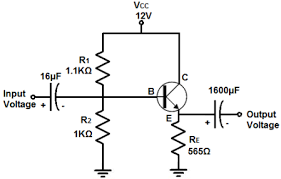
Buffer amplifiers, or buffers, are small circuits that provide impedance transformation between one circuit and another. They are used between different signal stages or between circuits with differing impedance characteristics to prevent loading effects that could alter current or voltage. This article describes buffer amplifiers, how they operate, their applications, and their advantages. The main types are voltage buffers and current buffers.
Voltage Buffer Amplifiers
A voltage buffer transfers voltage from a circuit with a high output impedance to another circuit with a low input impedance. Inserting a buffer between the two prevents the second circuit from overloading the first, which could disrupt its intended operation. Ideally, a voltage buffer has infinite input resistance and zero output resistance, effectively behaving like an ideal voltage source with perfect linearity and instantaneous response. A common form is the unity-gain buffer, or voltage follower, where the output voltage faithfully tracks the input. Although the voltage gain is approximately 1, the buffer typically provides significant current and power gain; its voltage gain is therefore described as unity (or 0 dB).
Current Buffer Amplifiers
A current buffer is used to transfer current from a circuit with low output impedance to another circuit with high input impedance. Its purpose is to prevent the second circuit from drawing excessive current from the first, avoiding disruption of the source. An ideal current buffer exhibits infinite output impedance (acting as an ideal current source) and zero input impedance (acting like a short). Like the ideal voltage buffer, the ideal current buffer shows perfect linearity and instantaneous output response regardless of signal amplitude or rate of change. When the current gain is unity (current gain βi = 1), the device is a unity-gain current follower: the output current follows the input current without division or alteration.
Operation
A buffer amplifier is a noninverting amplifier with unity gain. It commonly uses an op amp as the core element. An op amp is a high-gain differential amplifier with two inputs (inverting and noninverting) and one output. The input voltage is applied to the noninverting input while the inverting input is typically tied to the output via feedback. Due to the op amp's very high open-loop gain, it drives the output to null the voltage difference between its inputs, resulting in the output voltage following the input voltage with a gain of 1.
Advantages of Buffer Amplifiers
- Impedance matching: Buffers act as impedance translators. They present very high input impedance, drawing minimal current from the source, and very low output impedance, allowing them to drive low-impedance loads without significant signal attenuation.
- Signal isolation: Buffers provide isolation between input and output circuits. When connecting components with different input and output impedances, buffers ensure each circuit operates independently, preventing unwanted interactions.
- Signal preservation: Although buffers have unity voltage gain, they are often used in cascaded stages with other amplifiers. Their role is to preserve signal integrity and minimize distortion, making them essential in signal chains.
Applications
Typical applications of buffer amplifiers include:
- Audio systems: Buffers are used to match audio sources, such as microphones or instruments, to receivers or recording equipment, minimizing signal loss and preserving fidelity.
- Sensor interfaces: In sensor applications (for example, temperature or pressure sensors), buffers convert a sensor's high-impedance output to a low-impedance signal that can be transmitted over longer distances without distortion.
- Voltage regulation: Buffers appear in voltage regulation circuits as voltage followers, providing a stable, well-regulated output that follows an analog input voltage.
- Active filters: Buffers are used in active filter circuits to isolate the filter's passband from the load, preventing loading effects that could alter filter characteristics.
Typical Buffer Amplifier Circuit
A basic buffer amplifier uses an op amp with the noninverting input connected to the signal source and the inverting input tied directly to the output. This feedback provides unity gain. Proper power supply connections for the op amp are required to ensure normal operation.
Conclusion
Buffer amplifiers are key components in many electronic applications, helping with impedance matching, signal isolation, and voltage buffering. As unity-gain amplifiers, they minimize signal distortion, making them indispensable in many signal-processing circuits. Continued advances in electronics are expected to sustain the importance of buffer amplifiers for maintaining signal integrity and improving overall system performance.
 ALLPCB
ALLPCB





